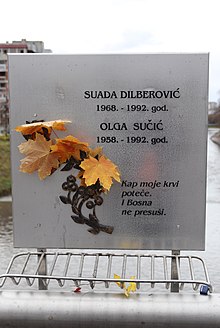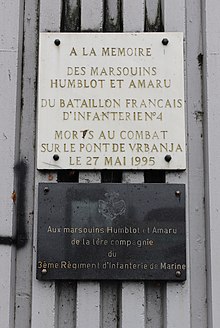Most Suade i Olge
The Most Suade i Olge (German: "Bridge of Suada and Olga") is a road and pedestrian bridge in Sarajevo , the capital of Bosnia and Herzegovina . It is located in the Marijin dvor settlement and spans the Miljacka River . First records of a bridge at this point date from the 18th century. Until 1996 it was officially called Vrbanja Bridge (Vrbanja most) as Vrbanja is an old and traditional name for the area on which the bridge was built.
The Vrbanja Bridge received international attention during the siege of Sarajevo in the Bosnian War (1992–1995).
Dates and location
It is about 40 m long, 18 m wide and spans the Miljacka, which is about 28 m wide at this point, in a north-south direction. On the south bank, the four-lane Zagrebačka Street runs from the Grbavica district to the bridge and from there as Terezija Street to the well-known Skenderija shopping center . On the north bank, the three-lane one-way street Vilsonovo šetalište also runs in a west-east direction to the intersection at the bridge and from there continues as Kotromanica Street . In a north-south direction from the bridge to the Sarajevo main road Zmaja od Bosne , the approx. 250 m long Vrbanja Street runs .
The bridge itself has four lanes, with two lanes in each direction of travel. There is also a walkway for pedestrians on both sides.
The bridge during the siege of Sarajevo (1992–1995)
In the early afternoon of April 5, 1992, 23-year-old Suada Dilberović and 34-year-old Olga Sučić died on the bridge from snipers who were located in the Kovačići district. The two women were out with other demonstrators for a peace demonstration on the forecourt of Parliament. Another demonstrator died on the bridge and four were injured. Shortly thereafter (2 p.m.) snipers from the Vraca district above opened fire on the bridge to the west (today Hamdije Čemerlića Bridge), injuring a civilian so seriously that he later died in hospital. The demonstrators were not deterred by this, penetrated the parliament building and declared it an "open people's parliament". In the course of the afternoon, more and more residents flocked to the peace demonstration and kept parliament occupied during the night, which is why Radovan Karadžić ordered some parts of the city to be closed on April 6th. When Karadžić received information that the assembled crowd was considering a peace march in the Serbian-dominated district of Vraca, he threatened further use of firearms if he entered "Serbian territory". Although the march to Vraca did not take place, around 2 p.m. snipers from the Holiday Inn across from Parliament opened fire on the peace demonstration and injured seven people. The hotel was the main headquarters of the Serbian Democratic Party at the time . The arrest of the suspected Serbian perpetrators by the Bosnian police led to the police academy being stormed by Serbian paramilitaries, and barricades were also erected. The murder of the two women on the bridge was interpreted by the Bosnian and Croatian sides as triggering the fighting in Sarajevo. In commemoration of this, the bridge was renamed Suada-Dilberović Bridge (Most Suade Dilberović) on April 6, 1996 and Suada-and-Olga Bridge on December 3, 1999 .
During the subsequent siege of the city by troops of the Army of the Republika Srpska (VRS), the front line at times ran directly to the bridge and separated the Serb-controlled Grbavica district from the Bosnian-held city center with the parliamentary district. Crossing the bridge was considered life-threatening, snipers dominated the area and shot randomly at passers-by of all ages. Later on, UN posts were built on both sides of the bridge.
On May 18, 1993, the 25-year-old Bosnian Serb Boško Brkić and his Bosniak friend Admira Ismić of the same age wanted to leave the besieged city across the Vrbanja Bridge when suddenly a sniper fired at the couple and Brkić was fatally killed on the bridge. Admira was also hit, crawled over to her injured boyfriend, and died about 15 minutes later. Their bodies could only be recovered after seven days due to the threat from snipers. The event was captured by international camera teams and appeared in numerous newspapers, mainly due to reports from Kurt Schork . The couple has become a symbol of the suffering of people on both sides because of their mixed ethnicity and a desire to escape the embattled city. The television stations PBS , CBC , NFB and WDR processed the events in the documentary "Romeo and Juliet in Sarajevo", which was awarded the Alfred Dupont Award . The American singer Bill Madden wrote the song "Bosko and Admira" for the event, the singer Jill Sobule the song "Vrbana Bridge".
On October 3, 1993, the Italian peace activist and UN aide Gabriele Moreno Locatelli was killed by a sniper while he was crossing the bridge with four escorts and a peace flag in his hands. This event inspired the filmmaker Giancarlo Bocchi to write the documentary “Morte di un pacifista” (“Death of a Pacifist”), and a street in Sarajevo was named after him ( Ulica Gabrijele Moreno Locatelli ).
Civilians continued to die on and at the bridge; on February 16, 1994, factory worker Ibrahim Osmić was fatally hit by a sniper while crossing the bridge.
The bridge gained further notoriety through the official first combat deployment of UN ground troops against soldiers of the Army of the Republika Srpska. On May 27, 1995, Serbian soldiers in French uniforms occupied the two UN posts on both sides of the bridge without a fight and captured 12 French UN soldiers. In response, French units stormed one of the two UN posts in a retaliatory attack and retook it after a violent exchange of fire. Four Serbian soldiers were killed and four others captured. The French had two casualties and 17 injured, including five seriously wounded.
Web links
Coordinates: 43 ° 51 ′ 11.9 " N , 18 ° 24 ′ 23.8" E


